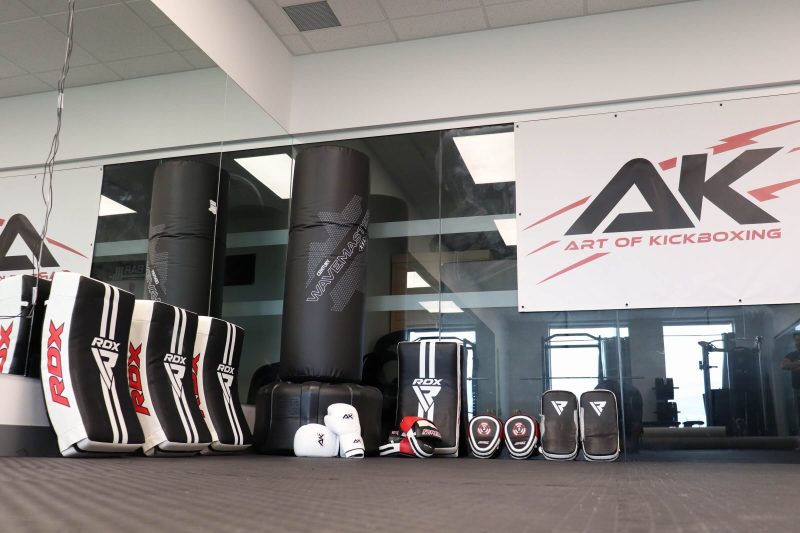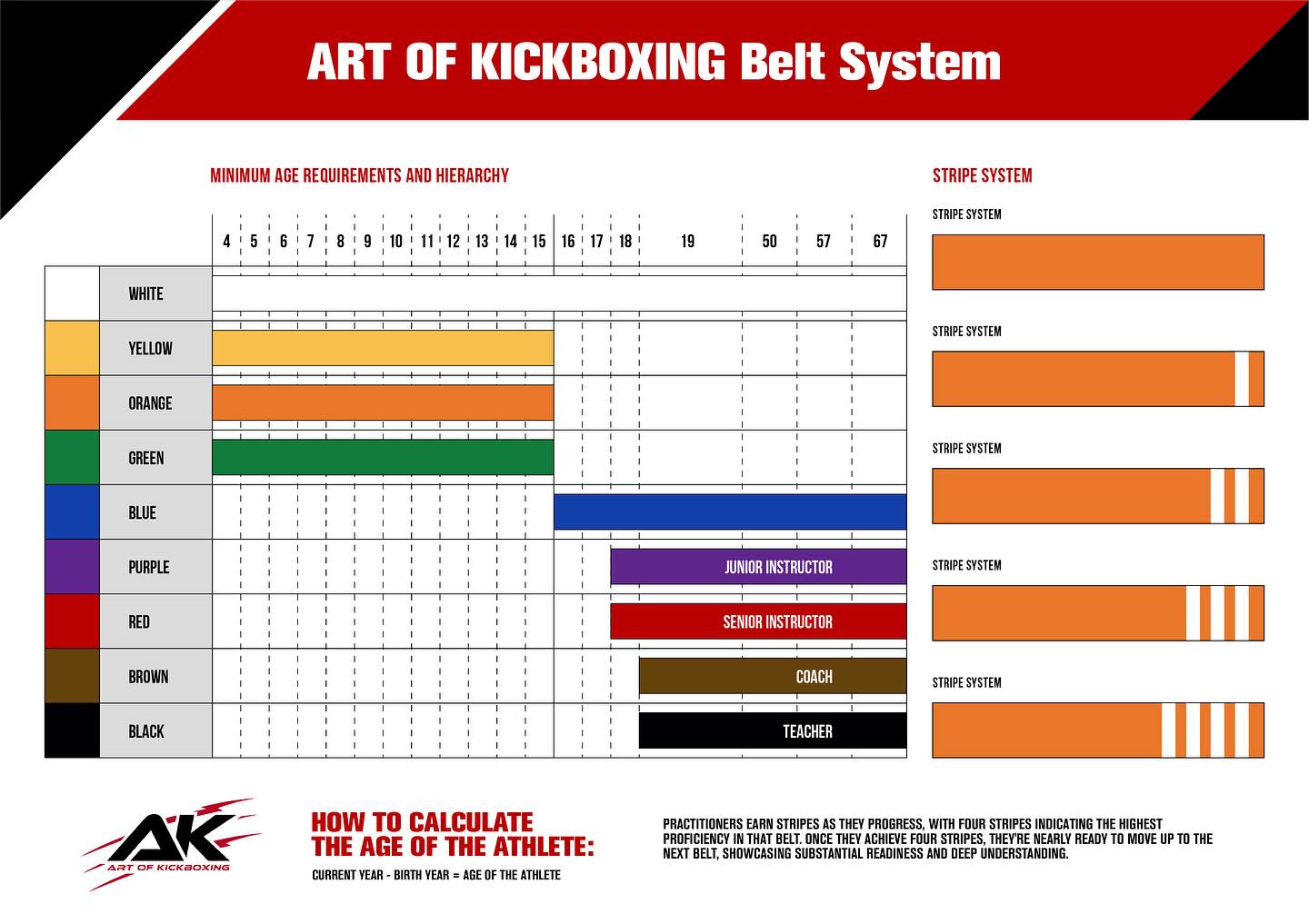Kickboxing Belt System
Kickboxing Belt Ranking Framework
Kickboxing Belt System
At Art of Kickboxing, we provide an exclusive kickboxing belt system that reflects your kickboxing mastery and, over time, allows you to pursue a career as an instructor or coach. You’ll begin with a white belt, learning the essential fundamentals. As you develop your skills, you’ll progress through color-coded belts: Yellow, Orange, Green, Blue, Purple, Red, Brown, and Black, each indicating a new rank of kickboxing mastery. Achieving a Black Belt is the pinnacle of your training, symbolizing advanced expertise, dedication, and a deep practical and theoretical understanding of kickboxing.
Kickboxing Belt Promotions
Kickboxing Belt Progression:
Stripe Levels & Advancing Belts
Our kickboxing belt system follows a structured progression where students advance through color-coded belts by mastering techniques and earning stripes along the way. The stripe system serves as a visual indicator of development within each belt level, ensuring consistent and measurable growth. We also provide hybrid belts to help students progress smoothly. Our hybrid belt system provides clear milestones and keep students motivated as they continue to advance to the next belt promotion.
Stripe Progression: Each belt—White, Yellow, Orange, Green, Blue, Purple, Red, Brown, and Black—includes up to four stripes, with each stripe representing a higher level of skill mastery and technical understanding within that belt.
Hybrid Belt System: Hybrid belts are progression ranks that require eight stripes instead of four in order to be promoted to the next belt. The purpose of our hybrid belt system is to allow students to progress through belt “milestones” as they develop the skills required for the next major belt promotion until they reach the Green-Blue Belt, where they transition back to the standard four-stripe system.
Belt Promotions: Once a student earns all four stripes on their current belt, they are considered nearly ready to be promoted to the next belt, showcasing both technical skill mastery and mental readiness.
Age Requirements: Belt progression is age-dependent, beginning at age 4 for White Belt and requiring age 19 or older for eligibility to earn a Black Belt.
Instructor Pathway: After achieving a Purple Belt, students can continue into instructor and coach roles from Junior Instructor, Senior Instructor, Coach, and Teacher.
Hybrid Belt System
Hybrid Belt Progression
- Hybrid belts (White-Yellow, Yellow-Orange, Orange-Green, Green-Blue) are used for students’s skill mastery progression between major ranks.
- Hybrid belts require 8 stripes before promotion.
- Once students reach the Green-Blue Belt, they switch to the standard 4-stripe progression.
Ranking Up Towards A New Career
Become a Kickboxing Coach
As you ascend through the belt ranks, you’ll not only enhance your personal skills but also take on greater roles within our community, potentially rising to a Senior Instructor or even a Coach. This structured system is designed to promote personal growth and physical prowess, preparing you for advanced techniques, competitive events, and a deep understanding of martial arts.
Our kickboxing belt system promotes a gradual and measurable advancement through the acquisition of skills and maturity, suitable for the physical and cognitive development associated with different age groups. Pursue the art of kickboxing with us and develop an arsenal of techniques and skills to bring with you for the rest of your life.
FAQS
Frequently Asked Questions
1. What is considered for belt promotions (What differentiates a Green Belt from a Blue Belt?)
Promotions are based on skill, consistency, and performance in class. A Green Belt shows solid fundamentals, while a Blue Belt demonstrates more complete development—good defense, ability to apply the fundamentals under pressure, and a level of experience similar to a Blue Belt in Jiu-Jitsu. They may not always chain everything together smoothly, but they show strong, well-rounded skills.
2. Does the Kickboxing Belt System take into consideration Boxing, Muay Thai, and MMA training at Art of Kickboxing?
Yes—while the system is built on kickboxing, we recognize transferable skills from all our classes, including our Boxing and Muay Thai classes. A student’s performance in those classes can support their belt progress, but belt promotions are evaluated primarily within the kickboxing program.
3. Is there a written or theoretical component to belt tests, especially for higher ranks?
No. We don’t hold written or formal tests. Progress is evaluated directly in class, based on technical ability, understanding, and consistency. At higher levels, students are also expected to show knowledge and teaching ability naturally during training.
4. How often are belt testing opportunities held?
There are no set days for belt promotions. Promotions happen when a student consistently shows the skills and readiness for the next level.
5. How long does it typically take to progress from one belt to the next? How long does it take to get a black belt?
Progression varies by student, but on average, it may take 6–12 months between belts with consistent training. Achieving a black belt usually takes several years of dedication, often 6–8 years, depending on commitment and performance.
6. Is there a separate belt criterion for children vs adults?
Yes. Children follow an age-appropriate curriculum with additional intermediate belts to help with motivation and progression. Adults follow a more structured ranking path with higher expectations for technical depth and sparring ability.
7. If a student trained elsewhere, can they transfer into the system with their current belt or must they start over?
We welcome students from other schools, but since our curriculum is unique, new students are evaluated based on our system. Prior experience will be recognized, and placement may be adjusted, but belts are awarded within Art of Kickboxing’s framework.
8. Does the belt system align with any national or international kickboxing organizations or standards?
Our kickboxing belt system is independent, designed specifically for Art of Kickboxing, and unique to our school. It draws on recognized techniques and standards from kickboxing, Muay Thai, and boxing, but is structured to fit our unique teaching approach and student progression.
9. What is the Purpose of a Kickboxing Belt System?
In many martial arts schools like ours, a belt grading system is often used to signify the skill level and expertise of practitioners. While the belt colors and black belt grades may differ from school to school, common ranks include White, Yellow, Orange, Green, Blue, Purple, Brown, and various degrees of Black Belt. Each colored belt represents a higher level of mastery over complex combinations and a deeper understanding of kickboxing skills.
Advanced training methods and rigorous training sessions help kickboxers progress through the belt ranks. In kickboxing, the level of expertise is not only displayed by the color of the belt but also by additional stripes or degrees, with a Black Belt indicating a high degree of proficiency. Belt grading involves a range of fitness levels and techniques, from basic strikes to advanced defensive maneuvers.
The journey to a Black Belt involves consistent training, knowledge of techniques, and personal growth. The form of kickboxing varies, incorporating elements from various martial arts systems, and the curriculum is structured to reflect this diversity. Whether it’s American Kickboxing, Muay Thai, or a blend of styles, the belt system serves as a roadmap for the martial artists’ progression and milestones in their kickboxing journey.
10. Is There a Kickboxing Belt System in Every Kickboxing Gym?
Not all kickboxing gyms or schools have a belt system. Many kickboxing institutions focus primarily on fitness, technique development, and preparation for competition without incorporating a traditional ranking structure. While the belt system is deeply rooted in martial arts history, providing a clear pathway for progression and achievement, it is not a universal feature of kickboxing.
Some practitioners value the belt system for its motivational and structural benefits, yet others thrive in environments where the emphasis is placed on personal improvement, competitive success, and mastery of skills without the formalities of a tiered ranking.
10. How do Kickboxing Belts compare to Brazilian Jiu-Jitsu Belts?
While both kickboxing and Jiu-Jitsu use a belt system to denote skill levels, there are key differences in their approach and symbolism. In Jiu-Jitsu, the belt colors typically progress from white, blue, purple, brown to black, each signifying a deeper understanding and mastery of techniques. The journey from one belt level to another in Jiu-Jitsu often involves rigorous training, a structured curriculum, and demonstration of practical combat skills, with each belt color symbolizing a distinct level of expertise.
In contrast, the belt system in kickboxing varies from school to school, and not all kickboxing styles use a belt system. Those that do, like American Kickboxing or certain forms of competitive kickboxing, might include belts such as yellow, orange, green, blue, brown, and black. These colors might differ in meaning compared to Jiu-Jitsu, often representing a combination of physical fitness, mastery of kickboxing skills (like punches, kicks, and elbow strikes), and understanding of offensive and defensive maneuvers. Advanced belts in kickboxing, like in Jiu-Jitsu, typically denote a high level of expertise and may involve mastery of complex combinations and defensive techniques.
11. Does Professional Kickboxing Use a Belt System?
In professional kickboxing, the concept of a belt system is different from traditional martial arts like Karate or Jiu-Jitsu. Professional kickboxing focuses more on competitive fighting and skill demonstration in the ring rather than a progression through a series of colored belts based on skill levels or knowledge.
Instead of a belt ranking system, professional kickboxing often recognizes fighters’ achievements and skill levels through titles and championships. These titles are awarded based on performance in professional fights and tournaments.
For example, organizations like K-1, Glory, or the World Kickboxing Association host championship fights where the winners earn titles like “World Champion” or “National Champion.” These titles are akin to championship belts in boxing and are more about holding a competitive title than denoting a progression of skill levels as in traditional martial arts.

Here’s our schedule & pricing plans. Feel free to contact us for more information.
Start Your Kickboxing JourneY
Achieve Your Kickboxing Belt Rank in Metro Vancouver
Learn kickboxing in Metro Vancouver at Art of Kickboxing, where our exclusive structured belt system is designed for learners of all levels, from beginners to aspiring instructors.
Starting with a white belt, our program guides you through a series of color-coded belts, each representing a new stage of kickboxing mastery. Our kickboxing belt system is suitable for everyone – kids, teens, and adults, ensuring a structured and progressive learning experience.
Improve your skills and confidence in a supportive environment. Join us for kickboxing classes and personal training sessions that cater to your individual pace and goals. Whether you’re aiming to improve fitness, learn self-defense, or pursue a kickboxing career, our kickboxing belt system provides a clear path of advancement.


